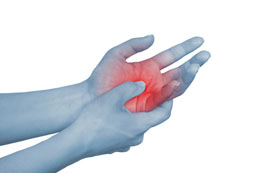Joint pain in hands can also be the result of an underlying disorder such as arthritis. Even a simple bone fracture or a hand sprain can make the joints sore.

A joint, as we all know is defined as a specific location in the body where two different bones connect. The ligaments and tendons are the parts of the joint that provide stability to the joint. The joints in the hand allow a person to freely move the fingers and the wrist. Joint pain that restricts hand mobility can be due to numerous causes, some of which are discussed below:
Causes
Arthritis: Arthritis involving the hand can cause swelling and inflammation of the joint. Arthritis that involves progressive deterioration of the joint, generally occurs after 50 in men and women. Arthritis restricts functionality of the joints and makes them stiff and red.
However, rheumatoid arthritis that often affects the hands and is common to people in the age group of 30 to 40, can also cause sore joint.
Bone Fracture: An outside force that causes breakage to any of the bones is sure to cause sore joints. In such a case, moving the hand becomes an uphill task and causes excruciating pain.
Carpal Tunnel Syndrome (CTS): People with CTS experience joint pain which is then accompanied by tingling sensation similar to that of pricking of needles in the fingers. CTS is a hand condition that results when the median nerve located at the wrist compresses due to an outside force. This is indeed a disabling condition that can also lead to hand numbness.
Hand Sprain: Ligaments and tendons are fibrous tissues that support the muscles and keep the bones in proper alignment. Falling on hand or joint movement that is not within the normal range can stretch the ligaments excessively and may lead to hand sprain. In this condition, joint pain occurs while holding heavy objects.
Hand Strain: A hand strain is an injury or a trauma that affects the tendon or the muscles. Muscle pain and localized swelling are the common symptoms of hand strain. A tendon is a fibrous cord that does the job of connecting the muscles to the bones. In this condition, the tendon or the muscle of the hand are partially or completely torn. Any joint movement that causes over stretching of the muscle or the tendon results in hand strain.
A proper treatment plan will be decided after thorough physical examination of the hand. The doctor may prescribe anti-inflammatory medications to relieve the pain in sore joints. An ice massage or a cold compress may also help to alleviate the pain.
Disclaimer: The information provided in this article is solely for educating the reader. It is not intended to be a substitute for the advice of a medical expert.


 A joint, as we all know is defined as a specific location in the body where two different bones connect. The ligaments and tendons are the parts of the joint that provide stability to the joint. The joints in the hand allow a person to freely move the fingers and the wrist. Joint pain that restricts hand mobility can be due to numerous causes, some of which are discussed below:
A joint, as we all know is defined as a specific location in the body where two different bones connect. The ligaments and tendons are the parts of the joint that provide stability to the joint. The joints in the hand allow a person to freely move the fingers and the wrist. Joint pain that restricts hand mobility can be due to numerous causes, some of which are discussed below: